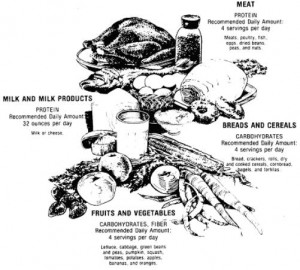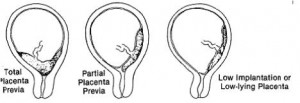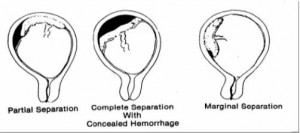a. Instruct the patient on the importance of regularly scheduled follow-up visits (following the normal pregnancy).
(1) Once a month until the seventh month.
(2) Every two weeks during the seventh and eight month.
(3) Weekly during the ninth month until delivery.
(4) Patient teaching must continue on each visit.
b. Instruct the patient on the importance of proper nutrition.
(1) A well-nourished mother and baby are thought to be far less the victims of obstetric and prenatal complications, such as:
(a) Preeclampsia.
(b) Prematurity.
(c) Growth retardation.
(d) Significant residual neurologic damage (that is, cerebral palsy, mental deficiency, or behavior disorders in the child).
(2) Guide to good eating-from the six basic food groups daily (see figure 6-4).
(a) Milk, yogurt, and cheese group-2 to 3 servings per day.
(b) Meat, poultry, fish, beans, eggs, and nuts group-2 to 3 servings per day.
(c) Vegetable and fruits-3 to 5 servings of vegetables and 2 to 4 servings of fruits per day.
(d) Breads, cereals, rice and pasta- 6 to 11 servings per day.
(3) Proper weight gain for pregnancy. After an initial loss, the patient will gain 2 to 4 pounds during the first trimester. Expect a gain of a pound per week during the second and third trimesters.

c. Instruct the patient on the importance of proper rest and sleep.
(1) Pregnancy will cause the patient to tire more easily.
(2) Prevention of fatigue through short rest periods is vital to good health.
(3) The amount of rest or sleep required will vary with the individual and stage of her pregnancy.
d. Instruct the patient on the importance of exercise and fresh air.
(1) The degree will vary according to her condition and stage of pregnancy.
(2) Walking is usually the exercise of choice.
(3) Swimming is an excellent overall exercise program.
e. Instruct the patient on precautions to take during pregnancy.
(1) Decrease smoking or stop altogether if possible.
(2) Restrict or limit alcohol intake.
(3) Avoid children with measles or other contagious diseases.
(4) Do not change kitty litter boxes or eat raw meats to prevent toxoplasmosis.
f. Instruct the patient on potential danger signs of pregnancy that would necessitate her contacting her physician and coming in.
(1) Any vaginal bleeding, regardless of how small, may indicate possible miscarriage or abortion, placenta previa, or placenta abruptio (see figures 6-5 and 6-6).


(2) Symptoms that may indicate preeclampsia. The symptoms are:
(a) Severe continuous headache.
(b) Dimness or blurring of vision.
(c) Swelling of the face or hands, especially when present after resting all night.
(d) Scotoma- lashes of lights or dots before the eyes.
(e) Persistent vomiting.
(f) Sharp pain in the abdomen.
(g) Epigastric pain.
(h) Weight gain greater than 4 pounds in one week.
(i) Chills and fever.
(j) Burning upon urination.
(k) Sudden escape of fluid from the vagina. The patient should report immediately to the physician or the hospital. She should not wait for uterine contractions to start.
(l) Lack of fetal movement over a 24-hour period once “quickening” has been established.
(m) Regular uterine contractions less than 5 minutes apart for an hour for anyone less than 37 weeks pregnancy.
